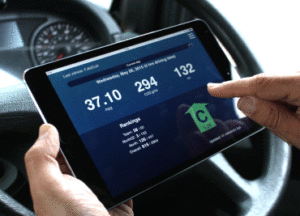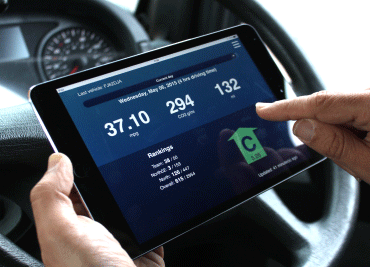 One of the biggest challenges faced by transport operators is how to achieve driver engagement with the telematics system they have in place. Where driver engagement can be successfully achieved, results are proven to be better and more sustained, leading to reduced operating costs, better safety levels and all the other benefits telematics brings.
One of the biggest challenges faced by transport operators is how to achieve driver engagement with the telematics system they have in place. Where driver engagement can be successfully achieved, results are proven to be better and more sustained, leading to reduced operating costs, better safety levels and all the other benefits telematics brings.
The other challenge with many telematics solutions is high levels of engagement comes at the price of higher management effort.
One of the key issues around engagement is how and when drivers gain access to their performance data. Is this done via driver debrief sessions? Do companies publish driver league tables to show relative performance vs colleagues? Is performance linked to bonuses and incentives?
How about giving drivers direct access through their own or company-owned mobile devices?
At Microlise, we are of the view that drivers should have direct access to their performance data. We’ve developed our Driver Performance Management mobile app for this very reason.
Here are ten reasons why we feel drivers should have access to their telematics performance information:
Empower drivers
Having direct access to telematics data empowers drivers by giving them the tools to understand and improve their own performance. If a driver knows this information is being collected, why not allow them to see how they are performing? Giving this access demonstrates trust in the individual, in terms of being able to view, understand and determine actions based on the information available.
Give them ownership
As well as empowerment, providing direct access also gives drivers true ownership of their driving performance measures. Drivers can see how they are performing against a range of criteria and how that performance directly correlates with events on the road. Some things are unavoidable, such a harsh brake because a car pulls out when it shouldn’t, but likewise drivers understand when a slip in scores in a certain criteria are down to them.
Ability to understand performance
Direct access also provides understanding. The Microlise DPM app breaks down performance into a range of criteria, such as harsh braking, speeding, harsh cornering, etc. A driver may be scoring A’s across the board, perhaps aside from one category where they are recording a D grade. By seeing that, he or she can understand where performance can be improved.
Self-improvement
Providing training is often expensive and doesn’t always yield great results. Can operators afford to take groups of drivers off the road for a day? Or financially afford to deliver one-to-one drivers when they may have a great many drivers on their books?
Direct access to telematics performance information allows drivers to identify areas of weakness and take action to address them, improving their own understanding and skills in the process, and removes the need for this kind of ineffective and costly training.
Competition/gamification
Gamification is an increasingly used term and a topic on the rise (in fact one we covered recently in a short whitepaper). Whether you use gamification, or more simply, look at providing a bit of healthy competition, telematics performance data can be used to allow drivers to understand how they are performing in relation to their colleagues.
Many successful operators are using telematics data to produce driver league tables and incentive schemes, offering prizes or bonuses where drivers deliver A grade ratings.
Drivers with direct access to their performance data can not only improve their own performance, but can aim to perform the best within the company, depot or just better than friends (or rivals!).
Improve quickly – in near real-time
As touched upon above, drivers with access to their telematics performance data can self-improve by addressing areas of weakness. Another benefit here is the speed at which they can do this.
With the Microlise DPM app for example, drivers can look at their performance over a day, a week, a month, etc, but the improvements they make as a result happen instantly. Furthermore, due to ongoing access to the information, these improvements are maintained as drivers seek to continue recording the more positive score.
Reduce management time
From a management perspective, giving drivers access to their telematics performance information saves time. Drivers improve their performance levels themselves and this has a knock-on effect, with increased safety levels (so less incidents occurring across the fleet), efficiency and reduced fuel costs…all of which help to ensure a smooth running transport operation, releasing management to focus on areas of value-add.
Manage by exception
Further to the previous point, managers and team leaders can manage the exceptions rather than committing the same time to all drivers.
With drivers self-regulating and developing their own skills, management time and training resources can be directed at those drivers that require it more. For example rather than delivering training to a group of drivers, managers can identify individual drivers that might require a specific piece of training to help them address an area of weakness.
No need for driver debriefs
Related to the previous point is the reduced need for driver debriefs. Drivers who are performing well and either achieving good scores or showing steady improvement will not require as regular debriefs, which are often difficult and/or time consuming meetings. This saves time for both driver and manager and again allows for management-by-exception where debriefs only occur when performance slips or where one is required for a specific reason.
By providing a facility to engage through mobile apps, transport operators can also ‘debrief on the go’. Microlise not only provides drivers a detailed breakdown of their scores and any incidents (such as harsh brakes) recorded, but also allows transport operators to ‘debrief-on-the-go’, where if a driver takes more time or travels more miles than was planning, they are prompted to record a reason. This likewise minimises the need for face-to-face debriefs as the reasons for variations against plan are recorded in a systematic way.
Help driver retention
With a driver shortage of around 45,000 according to RHA figures, retaining drivers is a key issue for transport operators. High churn impacts an operator in various ways, but by empowering drivers and giving them the tools to perform well, retention is aided. Incentivising drivers, based on their telematics based performance to which they have constant access, can also aid retention as drivers are in control of their ability to earn bonuses or prizes (depending on the incentive scheme in place).
Here at Microlise, we believe there are lots of benefits to providing drivers access to their own telematics performance information. If you are considering taking this step we’d be happy to talk more about our experiences and the technology that makes it possible.
Resources:
WHITEPAPER: IMPROVING DRIVER ENGAGEMENT THROUGH GAMIFICATION




